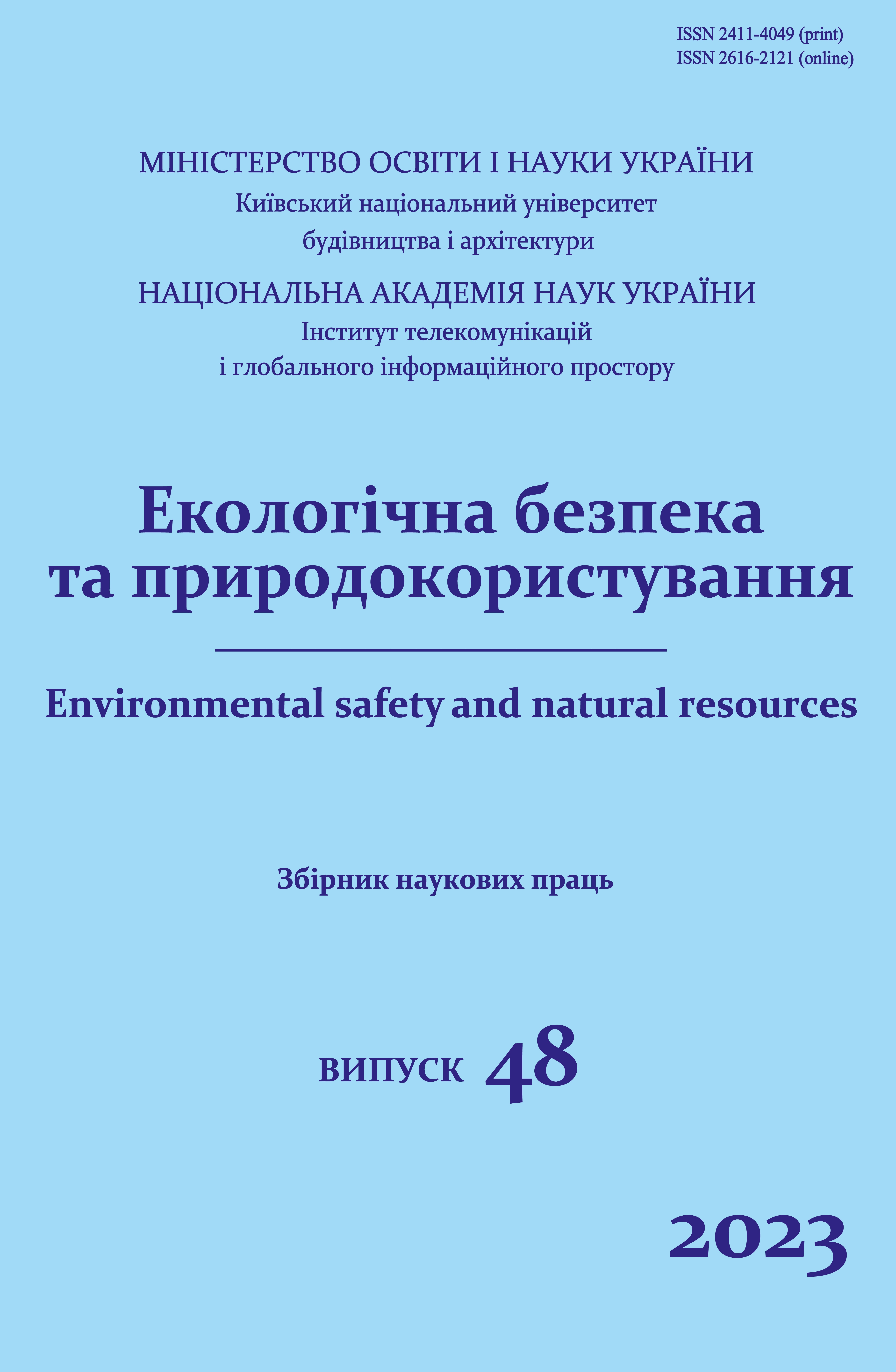Assessment of the determination of groundwater pollution parameters from destroyed ameliorative structures, tail storage and flooded landfills
DOI:
https://doi.org/10.32347/2411-4049.2023.4.21-31Keywords:
influence of military operations, pollution of water resources, aquifer, screens of reclamation facilities, filtration lossesAbstract
As a result of the damage to the structures of the supporting front and the destruction of the protective screens on the reclamation systems, tailings storage facilities, and landfills due to military operations, processes of flooding and pollution of water resources are taking place on the territory of Ukraine. This issue requires an assessment and forecast of the further development of events at the damaged buildings. An integral component of such an assessment is the methodology of approaches to the filtration calculations of the consumption of polluted water through a closed protective screen using the analysis of migration due to the aquifer. In this work, the issues of the theoretical approach to the determination of head loss and filtration through a protective screen for the assessment and further forecast of groundwater pollution by filtration flow from tailings, landfills, and reclamation canals due to their flooding due to military actions are considered. Approaches to the determination of pressure loss through a shielded structure in the event of various types of damage and at various stages of water filtration from channels are given. According to the proposed formulas, the loss of water from the main channel of the Ingulets irrigation system and the filtration coefficient of the damaged lining due to the destruction of the dam of the Kakhovskaya Hydro Electric Station were determined. The results of the research will be useful in making management decisions regarding the protection of water bodies from pollution and in the restoration of damaged structures.
References
Volvach Ya, Medvedev O. Blowing up the dam that saved Kyiv. Retrieved 23.05.2023 from https://nv.ua/ukr/ukraine/events/shcho-vidbuvayetsya-v-seli-demidiv-yake-zatopili-shchob-vryatuvati-kijiv-novini-ukrajini-50238773.html [in Ukrainian].
Nikolayeva, I., Lenko, G., Lobodzinskyi, O. (2019). Study of the current state of Donbas tailings repositories regarding their possible emergency impact on water bodies in the context of military operations. OSCE, Ministry of Energy and Environmental Protection [in Ukrainian].
The state of the Siversky Donets basin and influencing factors in the conditions of military operations. (2018). Technical report, Ministry of Ecology and Natural Resources of Ukraine [in Ukrainian].
Vechkanova, O. (2023). It's official: the Russians blew up the Kakhovskaya HPP. What's On, Full Details. Retrieved 30.05.2023 from https://telegraf.com.ua/mestnyiy/2023-06-06/5794325-ofitsiyno-rosiyani-pidirvali-kakhovsku-ges-ok-pivden [in Ukrainian].
Oliinyk, O.Ya., Kalugin, Yu.I. (2005). Some results of theoretical studies of mass transfer processes in porous media. Problems of water supply, drainage and hydraulics, 5, 100-112 [in Ukrainian].
Voloshkina, O.S., Kremez, V.S., Oliynyk, O.E. (2012). Theoretical justification of groundwater filtration and migration of pollutants and fertilizers in the areas of irrigated lands. Environmental safety and natural resources, 10, 5–24 [in Ukrainian].
Shcherbak, O.V., Yakovlev, E.O., Dolin, V.V. (2018). Modeling of the groundwater hydrogeofiltration field in the zone of influence of metallurgical production. Mineral Resources of Ukraine, 3, 19-25 [in Ukrainian].
Telima, S.V. (2002). On some aspects of the study of geofiltration in multilayer aquifer systems by the method of mathematical modeling. Urban Planning and Territorial Planning, 11, 138-146 [in Ukrainian].
Telyma, S.V., Voloshkina, O.S., Bereznytska, Yu.O., Efimenko, V.M. (2020). Modeling of the riverside groundwater intakes exploitation taking into account of the stream flow changes. In XIXth International Conference «Geoinformatics: Theoretical and Applied Aspects», (pp. 1–5). https://doi.org/10.3997/2214-4609.2020geo084
Design of anti-filtration facings and fastenings of channels of irrigation systems. Guide to the DBN "Reclamation systems and structures". Institute of hydraulic engineering and reclamation of the National Academy of Sciences. (2006) 2.4-1-99, 79 [in Ukrainian].
Manzoor Ahmad, Jamil Ahmad Tariq, Abid Rashid, Muhammad Rafiq, Naveed Iqbal. (2004). Study of seepage losses from irrigation canals using radioactive tracer technique. Retrieved 01.06.2023 from https://inis.iaea.org/collection/NCLCollectionStore/_Public/38/039/38039641.pdf
Xudong, H., Xiugui, W., Zhu, Y., Jiesheng, H., Liqing Y. (2019). An Experimental Study on Concrete and Geomembrane Lining Effects on Canal Seepage in Arid Agricultural Areas. Zhifu Chang and Feng Fu, 12(9), 2343. https://doi.org/10.3390/w12092343
Oleynyk, A.Ya. (1984). Geohydrodynamics of drainage. Kyiv: Naukova dumka [in Russian].
Bereznytska, Yu.O., Voloshkina, O.S. (2011). Modeling of inundation from structures with screens to assess the effectiveness of environmental protection measures. Environmental safety and natural resources, 7, 168-175 [in Ukrainian].
Telima, S.V., Oliynyk, E.O., Kurganska, S.M., Kharlamova, O.V. (2015). Modeling and calculations of intradrain hydraulics during operation of underground water intakes and drainages. Environmental safety and natural resources, 19, 33-43 [in Ukrainian].
Korver, A., Lorenz, E., Fyster, E., Galbraith, D., Gensch, R., Matta, J., Peter, M. (2022). Handbook on water supply technologies in emergency situations, UASANS, 1, 228 [in Ukrainian].
Podvihina, O.O., Zagrytsenko, A.M. (2019). Calculation of water losses from the canal and determination of the forecast position of the groundwater level under irrigation conditions. Methodological recommendations for performing laboratory work in the discipline "Remedial hydrogeology" for students of the training direction 6.040103, Geology. Donetsk, National Mining University. Retrieved 12.06.2023 from https://gig.nmu.org.ua/en/stud/metod_MLG.pdf [in Ukrainian].
Telima, S.V. (2015). Forecasting the water-salt regime of groundwater on irrigated lands based on data from field observations. Scientific and technical collection. Urban planning and territorial planning, 57, 443-449 [in Ukrainian].
Telyma, S., Voloshkina, O., Anpilova, Y., Efimenko, V., Yakovliev, Y. (2020). Forecasting emergency situations connected with regional flooding by groundwater in southern Ukraine. In 16th International May Conference on Strategic Management. Retrieved 15.06.2023 from http://mksm.sjm06.com
Voroshnov, S.M., Shevchuk, Y.V., Yuzyuk, O.Yu. (2018). Current technical condition of the channels of the Ingulets irrigation system and new lining designs using geosynthetic materials. Mechanization and Electrification of Agriculture, 8, 232-240 [in Ukrainian].
DBN V.2.4-1-99 "Melioration systems and structures". Approved by Order of the State Building of Ukraine dated 06.25.1999 No. 15 [in Ukrainian].
Downloads
Published
How to Cite
Issue
Section
License
Copyright (c) 2023 Marshall D.I., Shevchuk Ya.V.

This work is licensed under a Creative Commons Attribution 4.0 International License.
The journal «Environmental safety and natural resources» works under Creative Commons Attribution 4.0 International (CC BY 4.0).
The licensing policy is compatible with the overwhelming majority of open access and archiving policies.

